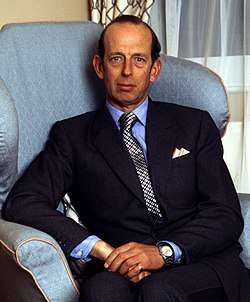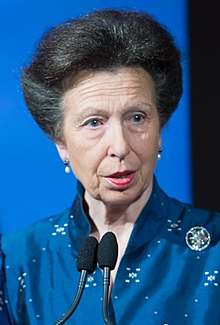Royal Academy of Engineering
 | |
| Motto | "To bring engineering to the heart of society" |
|---|---|
| Formation | June 1976 |
| Legal status | Royal Charter |
| Purpose | To advance and promote excellence in engineering |
| Headquarters | London, SW1 |
| Location | |
Membership | 3 Royal Fellows, 1,541 Fellows |
President | Professor Dame Ann Dowling OM DBE FRS FREng |
CEO | Dr Hayaatun Sillem |
Key people | Prince Philip |
Main organ | Board of Trustees |
| Website |
www |
The Royal Academy of Engineering (RAEng) is the UK’s national academy of engineering.
The Academy was founded in June 1976 as the Fellowship of Engineering with support from Prince Philip, Duke of Edinburgh, who became the first Senior Fellow and, as of 2018, remains so. The Fellowship was incorporated and granted a Royal Charter on 17 May 1983 and became the Royal Academy of Engineering on 16 March 1992. It is governed according to the Charter and associated Statutes and Regulations (as amended from time to time).[1][2]
History
Conceived in the late 1960s, during the Apollo space programme and Harold Wilson’s espousal of ‘white heat of technology’, the Fellowship of Engineering was born in the year of Concorde’s first commercial flight.[3]
The Fellowship's first meeting, at Buckingham Palace on 11 June 1976, enrolled 126 of the UK’s leading engineers.[4] The first fellows included Air Commodore Sir Frank Whittle, the jet engine genius,the structural engineer Sir Ove Arup, radar pioneer Sir George MacFarlane, the inventor of the bouncing bomb, Sir Barnes Wallis, father of the UK computer industry Sir Maurice Wilkes. The Fellowship’s first President, Lord Hinton, had driven the UK’s supremacy in nuclear power.[5]
The Fellowship focused on championing excellence in all fields of engineering. Activities began in earnest in the mid-1970s with the Distinction lecture series, now known as the Hinton lectures. The Fellowship was asked to advise the Department of Industry for the first time and the Academy became host and presenter of the MacRobert Award.[6]
In the 1980s, the Fellowship received its own Royal Charter along with its first government grant-in-aid. At the same time it also received significant industrial funding, initiated its research programme to build bridges between academia and industry and opened its doors to International and Honorary Fellows.[7]
In 1990, the Academy launched its first major initiative in education, Engineering Education Continuum, which evolved into the BEST Programme[8] and Shape the Future and Tomorrow's Engineers.[9]
The Academy’s increasing level of influence – in policy, research and education – was recognised when it was granted a royal title and became The Royal Academy of Engineering in 1992.[10]
The Logo
The Academy’s current logo is inspired by the Neolithic hand-axe, humans' first technological advance, which was taken to be a symbol appropriate to the Academy, supposedly representative of the ever-changing relationship between humanity and technology.[11]
Prince Philip House
The Academy's premises, 3-4 Carlton House Terrace, are in a Grade I listed building overlooking St James’s Park, designed by celebrated architect John Nash and owned by the Crown Estates. The Academy shares the Terrace with two of its sister academies, the British Academy and the Royal Society as well as other institutes.
The building was renamed Prince Philip House,<ref[http://www.princephiliphouse.com/</ref> in honour of the Senior Fellow, after renovation works were completed in 2012. Prince Philip House is also available for venue hire for meetings or events.
Presidents of the Royal Academy of Engineering
The President of the Royal Academy of Engineering, the elected officer of the Academy, presides over meetings of the Council. The President is elected for a single term of not more than five years.
| Years | President | |
|---|---|---|
| 1976-1981 | Christopher Hinton, Baron Hinton of Bankside | OM, Kt, KBE, FREng, FRS |
| 1981-1986 | Robin Inskip, 2nd Viscount Caldecote | DSC, KBE, FREng |
| 1986-1991 | Sir Denis Rooke | OM, Kt, CBE, FREng, FRS, |
| 1991-1996 | Sir William Barlow | Kt, FREng |
| 1996-2001 | Sir David Davies | Kt, CBE, FREng, FRS |
| 2001-2006 | Alec Broers, Baron Broers | Kt, FREng, FRS |
| 2006-2011 | John Browne, Baron Browne of Madingley | FREng, FRS |
| 2011-2014 | Sir John Parker | GBE, Kt, FREng |
| 2014- | Professor Dame Ann Dowling | OM, DBE, FREng, FRS |
Fellows of the Royal Academy of Engineering
The Fellowship currently includes over 1,500 engineers from all sectors and disciplines of engineering. The Fellows, distinguished by the title Fellow of The Royal Academy of Engineering and the postnominal designation FREng, lead, guide and contribute to the Academy’s work and provide expertise.[12]
Up to 60 engineers are elected each year by their peers. Honorary and International Fellows who have made exceptional contributions to engineering are also elected and are entitled to use respectively the designatory letters HonFREng and FREng after their name.[13]
The criteria for election are stated in the charter, statutes, and regulations document[14]. The essential attributes of excellence in engineering include:
- Organization leaders: those with full responsibility on technical decisions
- Top Engineers, academics or researchers: whose work have resulted in new products, important processes or practices.
- Top Engineers: those who have made outstanding contributions to major projects.
- Engineering department leaders: those who have demonstrated significant personal engineering achievements
The current President of the Academy is Professor Dame Ann Dowling OM, DBE, FREng, FRS, the first woman to hold the office. The Immediate Past President is Sir John Parker GBE FREng.
.jpg) Prince Philip
Prince Philip Prince Edward
Prince Edward Princess Anne
Princess Anne
The Royal Fellows of the Academy comprise Prince Philip, Prince Edward, Duke of Kent, and Anne, Princess Royal.
Activities
The Academy is instrumental in two policy alliances set up in 2009 to provide coherent advice on engineering education and policy across the profession: Education for Engineering[15] and Engineering the Future.[16]
The Academy is one of four agencies that receives funding from the UK's Department for Business Innovation & Skills for activities that support government policy on public understanding of science and engineering.[17]
As part of its programme to communicate the benefits and value of engineering to society, the Academy publishes a quarterly magazine, Ingenia. The Academy says that Ingenia is written for a non-specialist audience and is "aimed at all those with an interest in engineering, whether working in business and industry, government, academia or the financial community". The Academy also makes Ingenia available to A-Level students in 3,000 schools in the UK.
Diversity
The Academy strives to ensure that the pool of candidates for election to The Fellowship better reflects the diverse make-up of society as a whole. It set up the Proactive Membership Committee[18] in 2008 to identify and support the nomination of candidates from underrepresented areas, with the aim of boosting the number of women candidates, engineers from industry and Small and Medium Enterprises, those from emerging technologies and ethnically diverse backgrounds.[19]
Awards and prizes
- With the support of the Worshipful Company of Engineers, the Academy manages the annual Royal Academy of Engineering MacRobert Award, the premier prize for UK innovation in engineering. First presented in 1969, the award honours the winning company with a gold medal and the team members with a prize of £50,000.
- The Academy oversees the awarding of the Queen Elizabeth Prize, for Engineering. The QEPrize is an international, £1 million engineering prize that "rewards and celebrates the engineers responsible for a ground-breaking innovation that has been of global benefit to humanity". The objective of the prize is to "raise the public profile of engineering and to inspire young people to become engineers".[20]
- The Academy's Sir George Macfarlane Medal is an annual award that "recognises a UK engineer who has demonstrated excellence in the early stage of their career".[21]
- The President's Medal
- Chair in Emerging Technologies, a scheme providing long-term support to visionary researchers in developing technologies with high potential to deliver economic and social benefit to the United Kingdom.[22]
See also
References
- ↑ "RAEng: Charter, Statutes and Regulations". Retrieved 18 June 2015.
- ↑ "The Royal Academy of Engineering". Parliament of the United Kingdom. 1 September 2002. Retrieved 5 December 2012.
- ↑ Celebrating Concorde. Britishairways.com. Retrieved on 2013-08-13.
- ↑ "Founder Fellows". Royal Academy of Engineering. 10 June 1976. Retrieved 5 December 2012.
- ↑ History of The Academy - Early Days. Raeng.org.uk (1976-06-11). Retrieved on 2013-08-13.
- ↑ History of The Academy - 1976–1981: Establishing a track record. Raeng.org.uk. Retrieved on 2013-08-13.
- ↑ History of The Academy - 1981–1986: Growing influence and activities. Raeng.org.uk. Retrieved on 2013-08-13.
- ↑
- ↑
- ↑ History of The Academy - 1991–1996: From Fellowship to Royal Academy. Raeng.org.uk (1992-07-02). Retrieved on 2013-08-13.
- ↑ Visual Identity Guidelines. Raeng.org.uk. Retrieved on 2013-08-13.
- ↑ The Fellowship - List of Fellows. Raeng.org.uk. Retrieved on 2013-08-13.
- ↑ The Fellowship. Raeng.org.uk. Retrieved 12 December 2017.
- ↑ https://www.raeng.org.uk/about-us/what-we-do/charter-and-statutes
- ↑ "Education for Engineering (E4E)". Education for Engineering (E4E). Retrieved 7 September 2018.
- ↑ "Engineering the Future". Engineering the Future. Retrieved 7 September 2018.
- ↑ "2010 to 2015 government policy: public understanding of science and engineering". Gov.uk. Retrieved 7 September 2018.
- ↑ "Council and Committees: Proactive Membership Committee". 13 December 2011. Archived from the original on 13 December 2011. Retrieved 7 September 2018.
- ↑ Council and Committees: Proactive Membership Committee Archived 2011-12-13 at the Wayback Machine.. Raeng.org.uk. Retrieved on 2013-08-13.
- ↑ "Queen Elizabeth Prize for Engineering - Royal Academy of Engineering". Raeng.org.uk. Retrieved 7 September 2018.
- ↑
- ↑ "Academy funds global research visionaries to advance emerging technologies". Royal Academy of Engineering. 10 April 2018. Retrieved 11 April 2018.